Animal Toxicology: Testing, Alternatives, and Ethical Implications
VerifiedAdded on 2022/09/17
|6
|1319
|28
Report
AI Summary
This report delves into the field of animal toxicology, focusing on the use of animals in research to assess the safety and efficacy of various substances, particularly drugs. It explores the ethical arguments surrounding animal testing, highlighting the debate between the benefits of such testing and the potential for animal suffering. The report examines the role of toxicology testing in ensuring the safety of products and discusses the limitations of animal testing, including the availability of alternative methods like in vitro cell cultures and computer simulations. It also addresses the issue of unnecessary cruelty to animals, the inhumane treatment they may endure during testing, and the lack of direct applicability of animal test results to humans. The report further analyzes the high costs associated with animal testing and the need for careful extrapolation of results. Ultimately, the report emphasizes the importance of finding alternative testing methods that minimize harm to animals and provide more accurate and relevant results for human health.
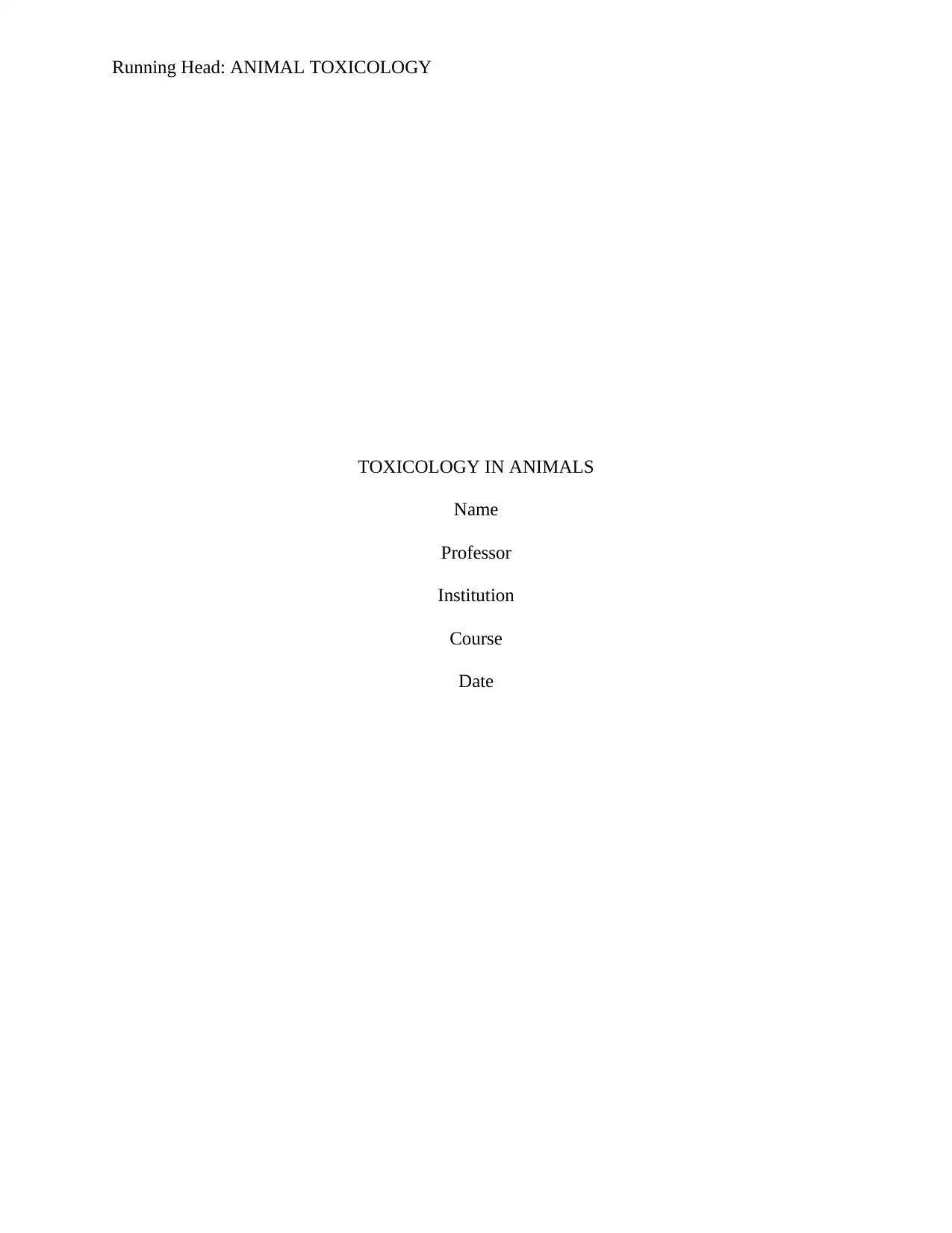
Running Head: ANIMAL TOXICOLOGY
TOXICOLOGY IN ANIMALS
Name
Professor
Institution
Course
Date
TOXICOLOGY IN ANIMALS
Name
Professor
Institution
Course
Date
Paraphrase This Document
Need a fresh take? Get an instant paraphrase of this document with our AI Paraphraser
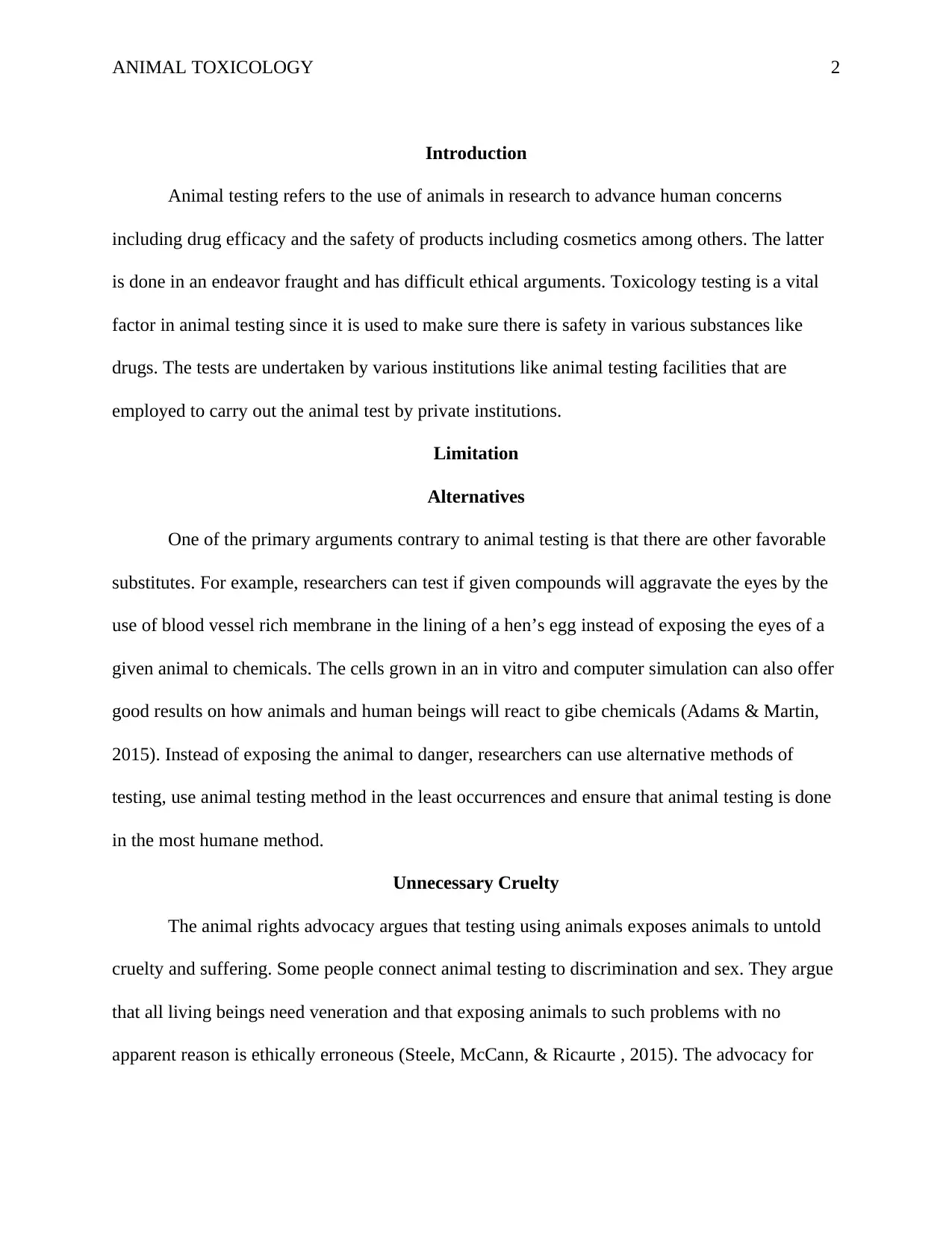
ANIMAL TOXICOLOGY 2
Introduction
Animal testing refers to the use of animals in research to advance human concerns
including drug efficacy and the safety of products including cosmetics among others. The latter
is done in an endeavor fraught and has difficult ethical arguments. Toxicology testing is a vital
factor in animal testing since it is used to make sure there is safety in various substances like
drugs. The tests are undertaken by various institutions like animal testing facilities that are
employed to carry out the animal test by private institutions.
Limitation
Alternatives
One of the primary arguments contrary to animal testing is that there are other favorable
substitutes. For example, researchers can test if given compounds will aggravate the eyes by the
use of blood vessel rich membrane in the lining of a hen’s egg instead of exposing the eyes of a
given animal to chemicals. The cells grown in an in vitro and computer simulation can also offer
good results on how animals and human beings will react to gibe chemicals (Adams & Martin,
2015). Instead of exposing the animal to danger, researchers can use alternative methods of
testing, use animal testing method in the least occurrences and ensure that animal testing is done
in the most humane method.
Unnecessary Cruelty
The animal rights advocacy argues that testing using animals exposes animals to untold
cruelty and suffering. Some people connect animal testing to discrimination and sex. They argue
that all living beings need veneration and that exposing animals to such problems with no
apparent reason is ethically erroneous (Steele, McCann, & Ricaurte , 2015). The advocacy for
Introduction
Animal testing refers to the use of animals in research to advance human concerns
including drug efficacy and the safety of products including cosmetics among others. The latter
is done in an endeavor fraught and has difficult ethical arguments. Toxicology testing is a vital
factor in animal testing since it is used to make sure there is safety in various substances like
drugs. The tests are undertaken by various institutions like animal testing facilities that are
employed to carry out the animal test by private institutions.
Limitation
Alternatives
One of the primary arguments contrary to animal testing is that there are other favorable
substitutes. For example, researchers can test if given compounds will aggravate the eyes by the
use of blood vessel rich membrane in the lining of a hen’s egg instead of exposing the eyes of a
given animal to chemicals. The cells grown in an in vitro and computer simulation can also offer
good results on how animals and human beings will react to gibe chemicals (Adams & Martin,
2015). Instead of exposing the animal to danger, researchers can use alternative methods of
testing, use animal testing method in the least occurrences and ensure that animal testing is done
in the most humane method.
Unnecessary Cruelty
The animal rights advocacy argues that testing using animals exposes animals to untold
cruelty and suffering. Some people connect animal testing to discrimination and sex. They argue
that all living beings need veneration and that exposing animals to such problems with no
apparent reason is ethically erroneous (Steele, McCann, & Ricaurte , 2015). The advocacy for
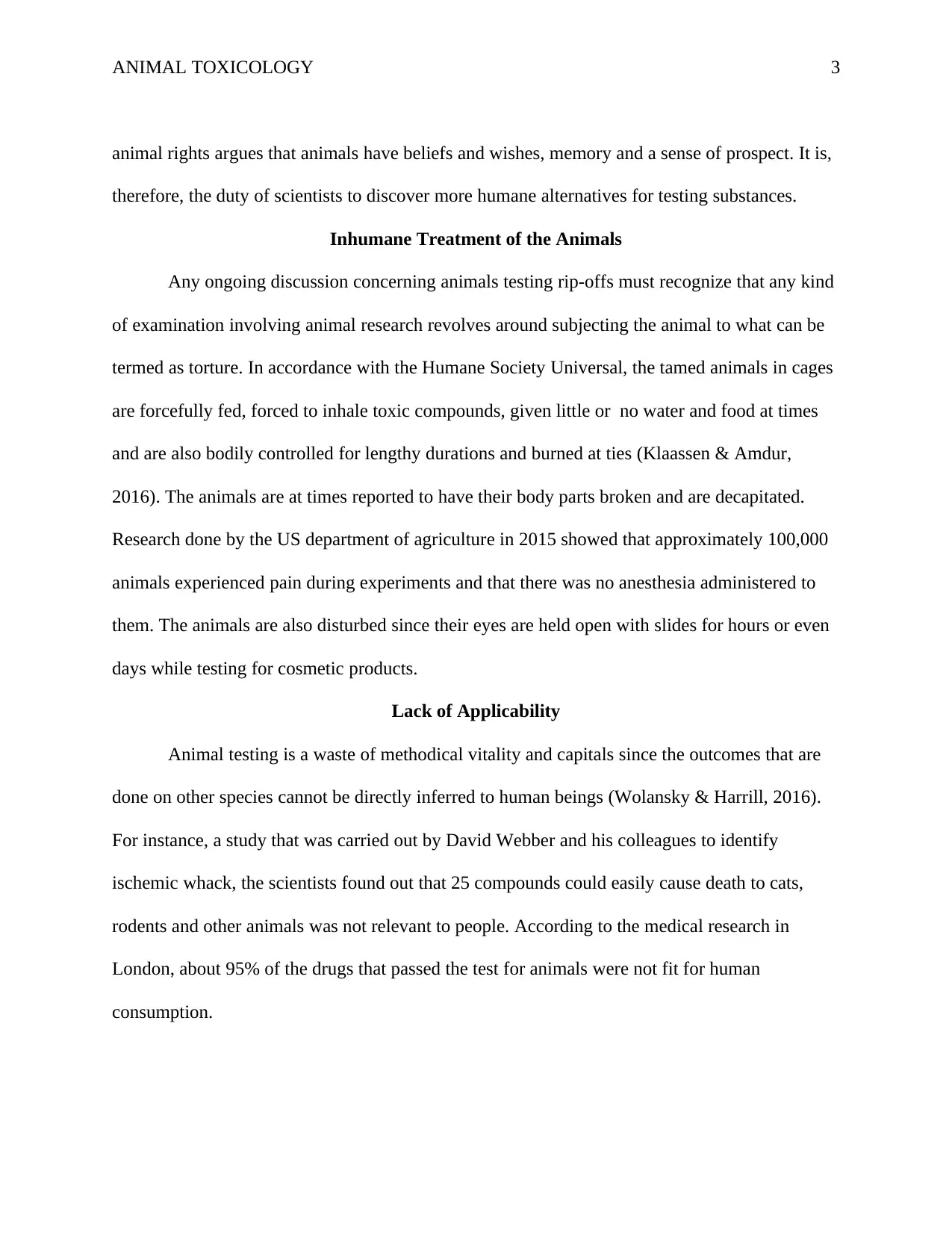
ANIMAL TOXICOLOGY 3
animal rights argues that animals have beliefs and wishes, memory and a sense of prospect. It is,
therefore, the duty of scientists to discover more humane alternatives for testing substances.
Inhumane Treatment of the Animals
Any ongoing discussion concerning animals testing rip-offs must recognize that any kind
of examination involving animal research revolves around subjecting the animal to what can be
termed as torture. In accordance with the Humane Society Universal, the tamed animals in cages
are forcefully fed, forced to inhale toxic compounds, given little or no water and food at times
and are also bodily controlled for lengthy durations and burned at ties (Klaassen & Amdur,
2016). The animals are at times reported to have their body parts broken and are decapitated.
Research done by the US department of agriculture in 2015 showed that approximately 100,000
animals experienced pain during experiments and that there was no anesthesia administered to
them. The animals are also disturbed since their eyes are held open with slides for hours or even
days while testing for cosmetic products.
Lack of Applicability
Animal testing is a waste of methodical vitality and capitals since the outcomes that are
done on other species cannot be directly inferred to human beings (Wolansky & Harrill, 2016).
For instance, a study that was carried out by David Webber and his colleagues to identify
ischemic whack, the scientists found out that 25 compounds could easily cause death to cats,
rodents and other animals was not relevant to people. According to the medical research in
London, about 95% of the drugs that passed the test for animals were not fit for human
consumption.
animal rights argues that animals have beliefs and wishes, memory and a sense of prospect. It is,
therefore, the duty of scientists to discover more humane alternatives for testing substances.
Inhumane Treatment of the Animals
Any ongoing discussion concerning animals testing rip-offs must recognize that any kind
of examination involving animal research revolves around subjecting the animal to what can be
termed as torture. In accordance with the Humane Society Universal, the tamed animals in cages
are forcefully fed, forced to inhale toxic compounds, given little or no water and food at times
and are also bodily controlled for lengthy durations and burned at ties (Klaassen & Amdur,
2016). The animals are at times reported to have their body parts broken and are decapitated.
Research done by the US department of agriculture in 2015 showed that approximately 100,000
animals experienced pain during experiments and that there was no anesthesia administered to
them. The animals are also disturbed since their eyes are held open with slides for hours or even
days while testing for cosmetic products.
Lack of Applicability
Animal testing is a waste of methodical vitality and capitals since the outcomes that are
done on other species cannot be directly inferred to human beings (Wolansky & Harrill, 2016).
For instance, a study that was carried out by David Webber and his colleagues to identify
ischemic whack, the scientists found out that 25 compounds could easily cause death to cats,
rodents and other animals was not relevant to people. According to the medical research in
London, about 95% of the drugs that passed the test for animals were not fit for human
consumption.
⊘ This is a preview!⊘
Do you want full access?
Subscribe today to unlock all pages.

Trusted by 1+ million students worldwide
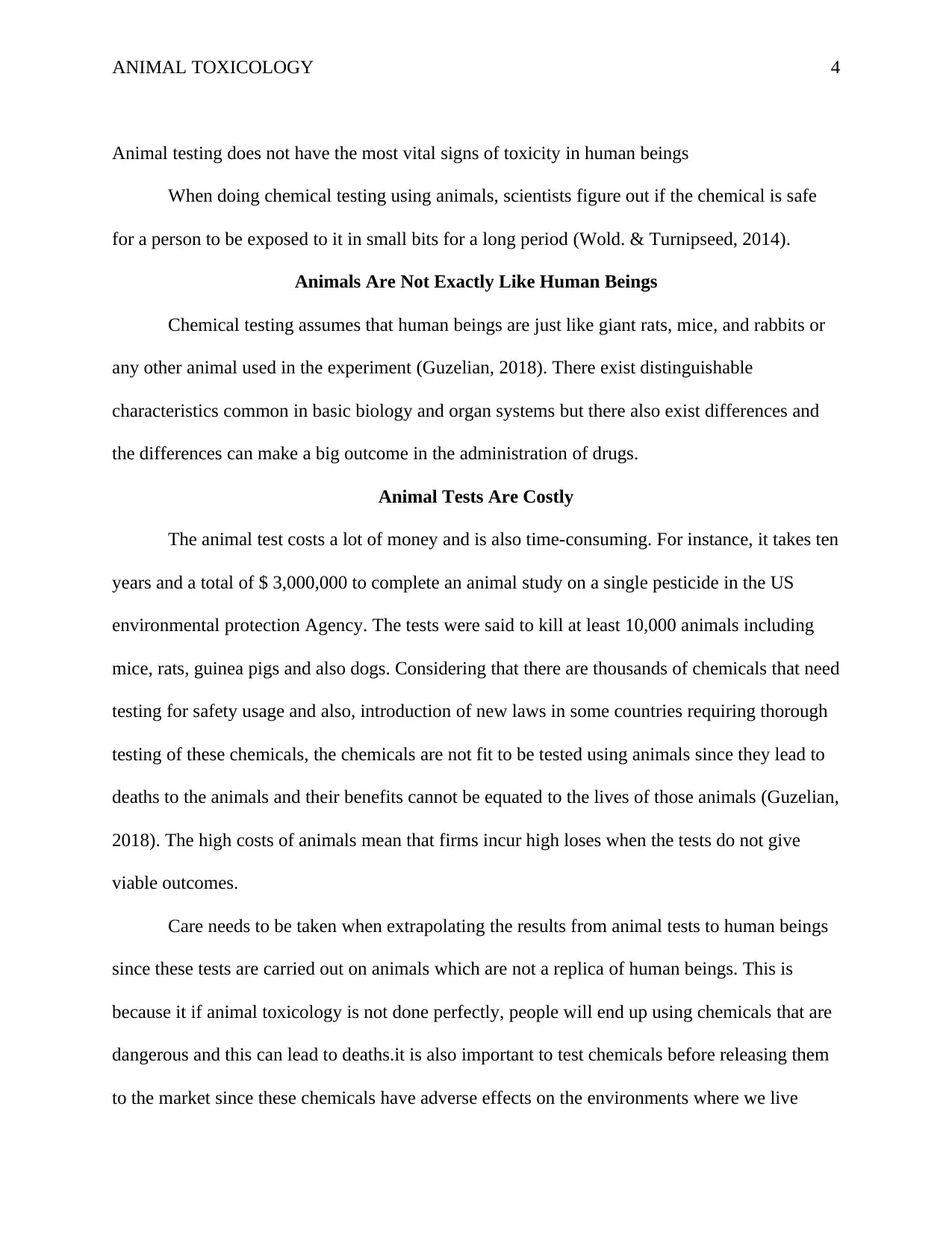
ANIMAL TOXICOLOGY 4
Animal testing does not have the most vital signs of toxicity in human beings
When doing chemical testing using animals, scientists figure out if the chemical is safe
for a person to be exposed to it in small bits for a long period (Wold. & Turnipseed, 2014).
Animals Are Not Exactly Like Human Beings
Chemical testing assumes that human beings are just like giant rats, mice, and rabbits or
any other animal used in the experiment (Guzelian, 2018). There exist distinguishable
characteristics common in basic biology and organ systems but there also exist differences and
the differences can make a big outcome in the administration of drugs.
Animal Tests Are Costly
The animal test costs a lot of money and is also time-consuming. For instance, it takes ten
years and a total of $ 3,000,000 to complete an animal study on a single pesticide in the US
environmental protection Agency. The tests were said to kill at least 10,000 animals including
mice, rats, guinea pigs and also dogs. Considering that there are thousands of chemicals that need
testing for safety usage and also, introduction of new laws in some countries requiring thorough
testing of these chemicals, the chemicals are not fit to be tested using animals since they lead to
deaths to the animals and their benefits cannot be equated to the lives of those animals (Guzelian,
2018). The high costs of animals mean that firms incur high loses when the tests do not give
viable outcomes.
Care needs to be taken when extrapolating the results from animal tests to human beings
since these tests are carried out on animals which are not a replica of human beings. This is
because it if animal toxicology is not done perfectly, people will end up using chemicals that are
dangerous and this can lead to deaths.it is also important to test chemicals before releasing them
to the market since these chemicals have adverse effects on the environments where we live
Animal testing does not have the most vital signs of toxicity in human beings
When doing chemical testing using animals, scientists figure out if the chemical is safe
for a person to be exposed to it in small bits for a long period (Wold. & Turnipseed, 2014).
Animals Are Not Exactly Like Human Beings
Chemical testing assumes that human beings are just like giant rats, mice, and rabbits or
any other animal used in the experiment (Guzelian, 2018). There exist distinguishable
characteristics common in basic biology and organ systems but there also exist differences and
the differences can make a big outcome in the administration of drugs.
Animal Tests Are Costly
The animal test costs a lot of money and is also time-consuming. For instance, it takes ten
years and a total of $ 3,000,000 to complete an animal study on a single pesticide in the US
environmental protection Agency. The tests were said to kill at least 10,000 animals including
mice, rats, guinea pigs and also dogs. Considering that there are thousands of chemicals that need
testing for safety usage and also, introduction of new laws in some countries requiring thorough
testing of these chemicals, the chemicals are not fit to be tested using animals since they lead to
deaths to the animals and their benefits cannot be equated to the lives of those animals (Guzelian,
2018). The high costs of animals mean that firms incur high loses when the tests do not give
viable outcomes.
Care needs to be taken when extrapolating the results from animal tests to human beings
since these tests are carried out on animals which are not a replica of human beings. This is
because it if animal toxicology is not done perfectly, people will end up using chemicals that are
dangerous and this can lead to deaths.it is also important to test chemicals before releasing them
to the market since these chemicals have adverse effects on the environments where we live
Paraphrase This Document
Need a fresh take? Get an instant paraphrase of this document with our AI Paraphraser
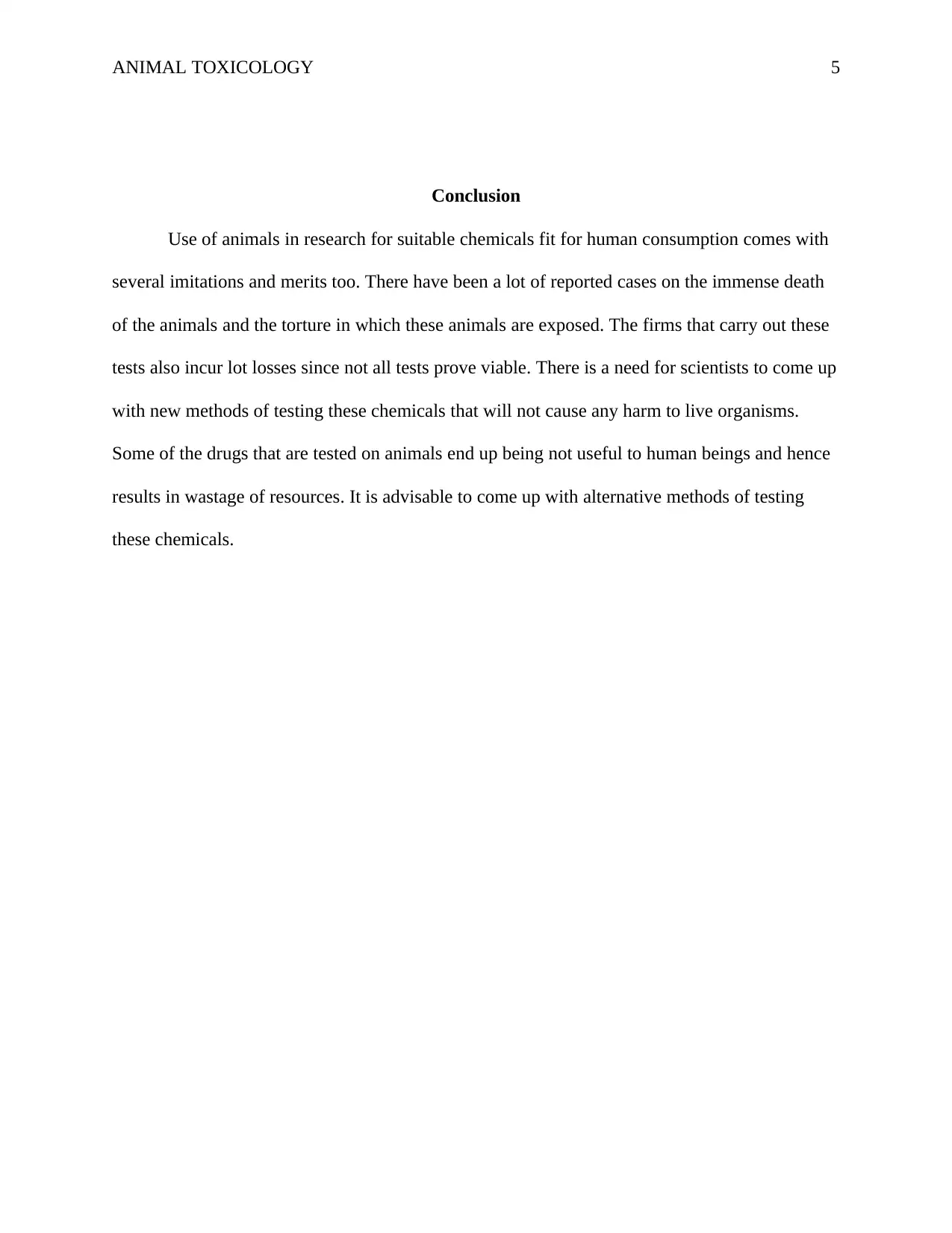
ANIMAL TOXICOLOGY 5
Conclusion
Use of animals in research for suitable chemicals fit for human consumption comes with
several imitations and merits too. There have been a lot of reported cases on the immense death
of the animals and the torture in which these animals are exposed. The firms that carry out these
tests also incur lot losses since not all tests prove viable. There is a need for scientists to come up
with new methods of testing these chemicals that will not cause any harm to live organisms.
Some of the drugs that are tested on animals end up being not useful to human beings and hence
results in wastage of resources. It is advisable to come up with alternative methods of testing
these chemicals.
Conclusion
Use of animals in research for suitable chemicals fit for human consumption comes with
several imitations and merits too. There have been a lot of reported cases on the immense death
of the animals and the torture in which these animals are exposed. The firms that carry out these
tests also incur lot losses since not all tests prove viable. There is a need for scientists to come up
with new methods of testing these chemicals that will not cause any harm to live organisms.
Some of the drugs that are tested on animals end up being not useful to human beings and hence
results in wastage of resources. It is advisable to come up with alternative methods of testing
these chemicals.
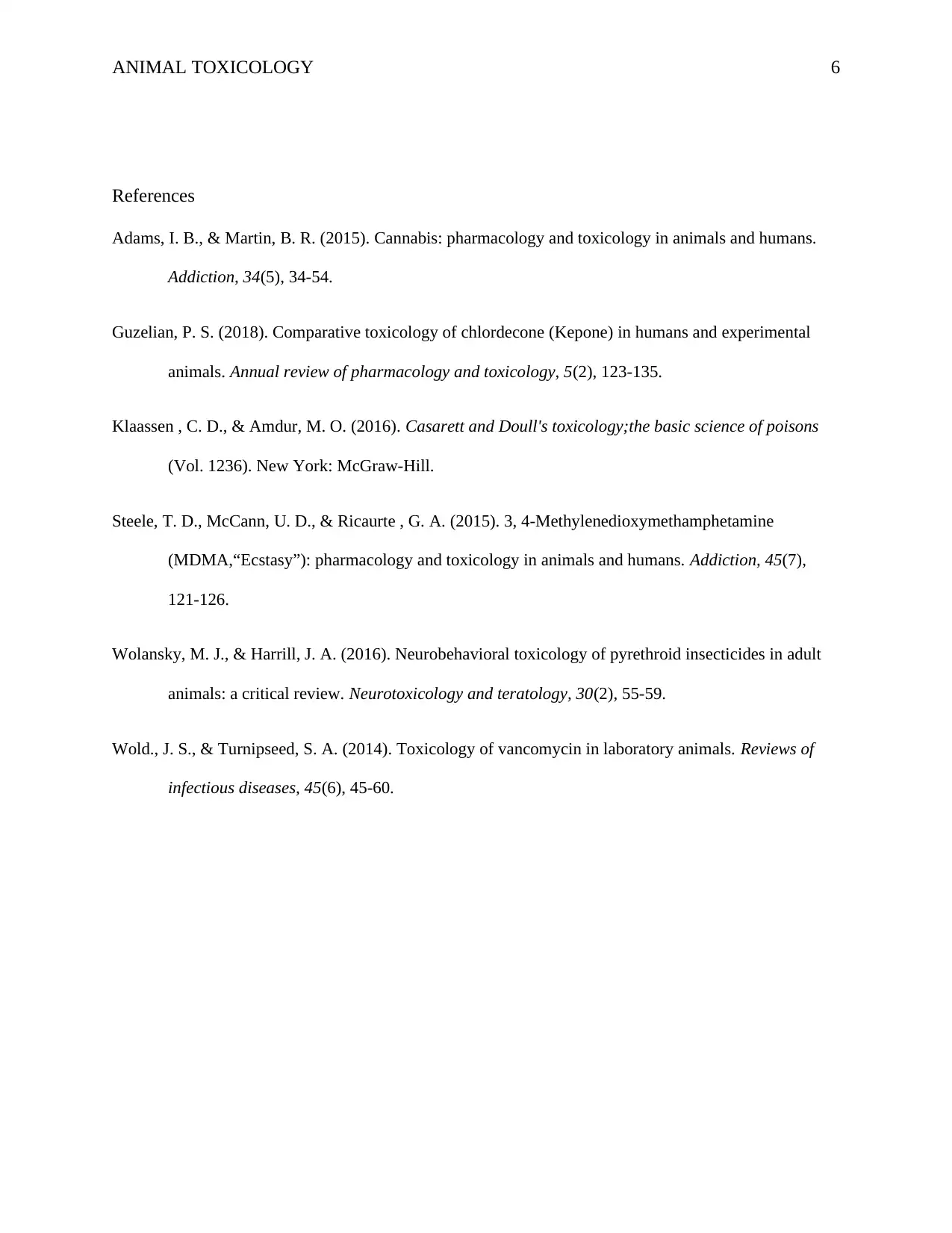
ANIMAL TOXICOLOGY 6
References
Adams, I. B., & Martin, B. R. (2015). Cannabis: pharmacology and toxicology in animals and humans.
Addiction, 34(5), 34-54.
Guzelian, P. S. (2018). Comparative toxicology of chlordecone (Kepone) in humans and experimental
animals. Annual review of pharmacology and toxicology, 5(2), 123-135.
Klaassen , C. D., & Amdur, M. O. (2016). Casarett and Doull's toxicology;the basic science of poisons
(Vol. 1236). New York: McGraw-Hill.
Steele, T. D., McCann, U. D., & Ricaurte , G. A. (2015). 3, 4‐Methylenedioxymethamphetamine
(MDMA,“Ecstasy”): pharmacology and toxicology in animals and humans. Addiction, 45(7),
121-126.
Wolansky, M. J., & Harrill, J. A. (2016). Neurobehavioral toxicology of pyrethroid insecticides in adult
animals: a critical review. Neurotoxicology and teratology, 30(2), 55-59.
Wold., J. S., & Turnipseed, S. A. (2014). Toxicology of vancomycin in laboratory animals. Reviews of
infectious diseases, 45(6), 45-60.
References
Adams, I. B., & Martin, B. R. (2015). Cannabis: pharmacology and toxicology in animals and humans.
Addiction, 34(5), 34-54.
Guzelian, P. S. (2018). Comparative toxicology of chlordecone (Kepone) in humans and experimental
animals. Annual review of pharmacology and toxicology, 5(2), 123-135.
Klaassen , C. D., & Amdur, M. O. (2016). Casarett and Doull's toxicology;the basic science of poisons
(Vol. 1236). New York: McGraw-Hill.
Steele, T. D., McCann, U. D., & Ricaurte , G. A. (2015). 3, 4‐Methylenedioxymethamphetamine
(MDMA,“Ecstasy”): pharmacology and toxicology in animals and humans. Addiction, 45(7),
121-126.
Wolansky, M. J., & Harrill, J. A. (2016). Neurobehavioral toxicology of pyrethroid insecticides in adult
animals: a critical review. Neurotoxicology and teratology, 30(2), 55-59.
Wold., J. S., & Turnipseed, S. A. (2014). Toxicology of vancomycin in laboratory animals. Reviews of
infectious diseases, 45(6), 45-60.
⊘ This is a preview!⊘
Do you want full access?
Subscribe today to unlock all pages.

Trusted by 1+ million students worldwide
1 out of 6
Your All-in-One AI-Powered Toolkit for Academic Success.
+13062052269
info@desklib.com
Available 24*7 on WhatsApp / Email
![[object Object]](/_next/static/media/star-bottom.7253800d.svg)
Unlock your academic potential
Copyright © 2020–2025 A2Z Services. All Rights Reserved. Developed and managed by ZUCOL.


